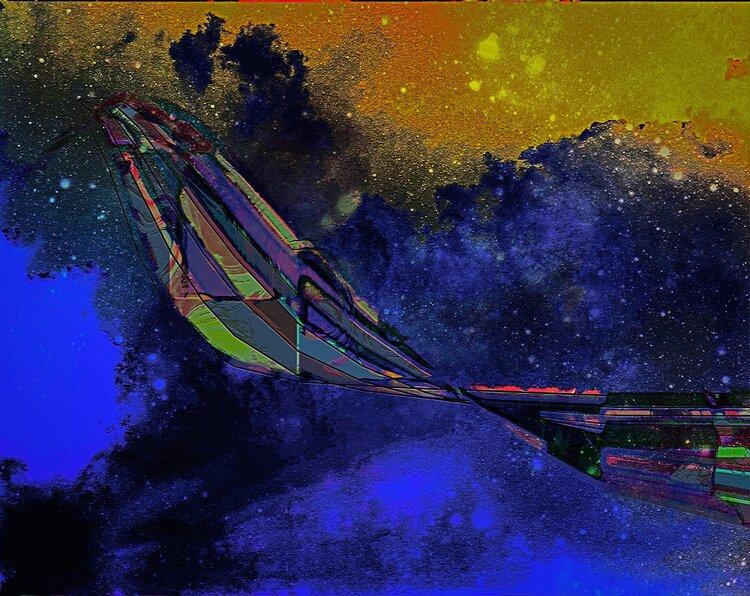Across campus, a new series of art installments is combining art and science to spark dialogue about climate change issues.
Artist Alisa Singer’s “Environmental Graphiti” is bringing science, beauty and hope to the forefront of the climate change movement, and some of her pieces are now installed in Regents Hall, the Intercultural Center, Lauinger Library and the Car Barn. The ECo Artwalk, commissioned by Georgetown’s Earth Commons Institute, features over 20 works of “Environmental Graphiti” by Singer.

Singer started working on the series in 2014, after she retired from a career as a corporate lawyer for over 30 years. Her retirement allowed her to dedicate herself to her art and to an issue she felt was particularly important: climate change.
“It occurred to me that people aren’t that interested in studying charts and graphs, they’re intimidating, they’re boring. There should be a way to make them more accessible, and to invite people in, and so I decided to try to create art from this compelling and important data, which is the best way to illustrate what’s happening,” Singer said in an interview with the Hoya.
Peter Marra, the director of the Earth Commons Institute, first saw Singer’s “Environmental Graphiti” in an exhibit at Loyola University Chicago and was immediately interested in bringing it to Georgetown.
“The best science to me, is also extremely creative and interesting. The art-science intersection, it makes you think about science in a very different way,” Marra said in an interview with The Hoya.
Marra reached out to Singer in early 2020 and worked closely with her until the Artwalk was installed in April 2022.
The exact locations of Georgetown’s pieces and a guided walking tour of them can be found on the Earth Commons’ website. Some of the pieces have been removed from Lauinger Library temporarily, but they will be relocated to a new permanent location by Fall 2023, according to Marra.
“The whole point was to not just have a collection in one spot, but to infiltrate the community and Georgetown campus in unsuspecting ways,” Marra said.
Marra said the hope that “Environmental Graphiti” inspires was part of the reason he wanted to bring it to Georgetown.
“I think the art allows us to sort of imagine things in a much more colorful light in a much more uplifting way,” Marra said.
Beyond Georgetown and Loyola, Singer’s “Environmental Graphiti” has been featured in scientific museums such as The Ontario Science Centre and several other universities, including the University of California, Irvine. It was also featured on the covers of numerous UN-sponsored Intergovernmental Panel on Climate Change reports from 2018, 2021 and 2022.
“The head of the UN committee made the final decision. And she said when she was introducing the art to the press, I chose this piece because it seemed the most hopeful,” Singer said.
The first step in Singer’s artistic process for a work of “Environmental Graphiti” is identifying a climate issue that she would like to bring to the attention of the public, from sea level rise to renewable energy possibilities. Singer then prioritizes finding credible data sources, and once she does, she asks herself if she can work directly with the given graphs or charts. If not, she will turn to a key word or number as the basis for the piece.
“I deconstruct the graph and reconstruct it as art, but I try to keep the basic elements there,” Singer said. “This is the process of trying to engage your interest and attention through the art.”
“Pathways for Reducing Emissions” is located on the sixth floor of the ICC and is inspired by a 2018 graph that projects possible outcomes of different responses that reduce carbon dioxide emissions that are necessary to prevent the mean global temperature from rising over two degrees Celsius. In the least proactive response, emissions continue to increase until about 2030, and significant carbon sequestration will be required to stay under the two-degree threshold.
Singer deconstructed the graph and reconstructed it as art while maintaining the basic design elements of the data.
“I’m not illustrating the graph. I’m trying to use it to create an independent work of art that will be aesthetically pleasing and stands alone, without any explanation, and intentionally appears abstract. The idea is to surprise people,” Singer said.
According to Marra, the art-science intersection is an opportunity to get others engaged with environmental issues.
“Being optimistic and hopeful doesn’t mean we’re not realistic. This is just a small example of where we can get others activated in thinking about the environment for that purpose,” Marra said.
To continue exploring the intersection of climate science and art, the Earth Commons and Georgetown University Art Galleries will be hosting a talk with artist Rebecca Rutstein on March 2. Rutstein creates immersive artistic experiences to foster dialogue about the climate crisis.
Singer’s use of an artistic medium intentionally creates a universal entryway into discussions about climate change issues, meditations and solutions.
“Art is global. Art is universal. This is a global problem. Art crosses boundaries: geographic, political, ideological, religious, language. It gets everybody into the room to start this critical discussion,” Singer said.








